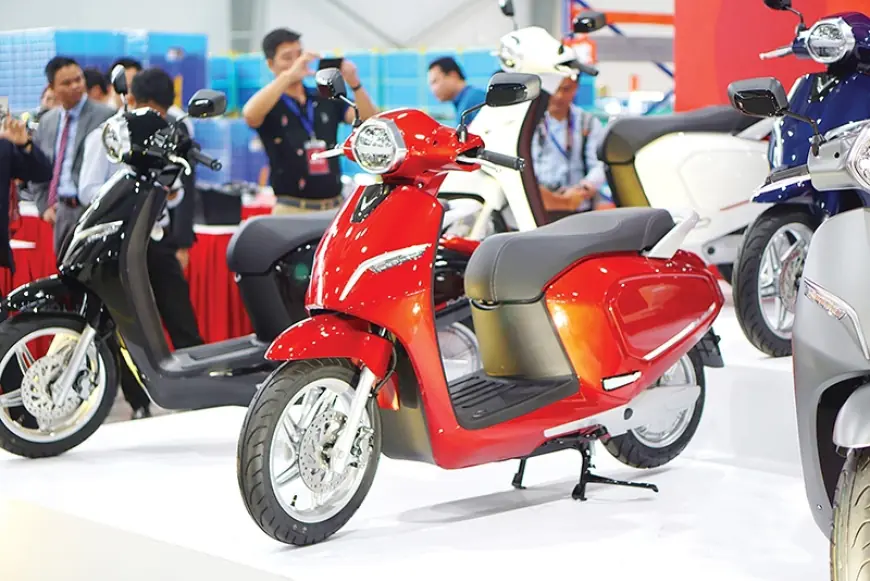Vietnam Two Wheeler Market 2030: Insights & Future Scope
As consumers shift preferences toward more stylish, feature-rich, and technologically advanced models, brands like Yamaha, Honda, and Piaggio are launching upgraded portfolios.

The Vietnam two-wheeler market is currently undergoing a dynamic and transformative evolution. Valued at USD 9.21 billion in 2024 and projected to reach USD 14.78 billion by 2030, with a CAGR of 8.2%, the market stands at the intersection of innovation, policy, and shifting consumer behavior. As Vietnam’s urban landscape continues to expand and industrialization surges forward, the role of two-wheelers is evolving from mere convenience to an integral part of smart mobility solutions.
Emerging Trends Shaping the Vietnam Two-Wheeler Market
1. Electrification and Green Mobility
Vietnam is emerging as a promising ground for electric two-wheelers. Environmental consciousness, combined with governmental incentives and initiatives, is driving the electric vehicle (EV) segment. Electric scooters and bikes are fast gaining popularity, especially among urban youth, due to their eco-friendly appeal, lower maintenance costs, and sleek modern designs. Manufacturers are responding with investments in R&D and charging infrastructure, aiming to capture this momentum.
2. Shared Mobility and Fintech Integration
The rise of the gig economy and shared mobility platforms is influencing bulk purchases in the commercial segment. Delivery services, ride-hailing, and scooter-sharing startups are increasingly turning to two-wheelers as a backbone for last-mile connectivity. Simultaneously, the adoption of fintech solutions—like installment-based vehicle purchases and digital insurance—has made vehicle ownership more accessible to the younger demographic and gig workers.
3. Smart Features and Connectivity
Connected vehicles are no longer the future—they’re here. GPS navigation, Bluetooth integration, anti-theft systems, and mobile diagnostics are becoming standard features in high-end two-wheelers. Local startups and global OEMs are focusing on delivering smart riding experiences that align with the tech-savvy preferences of modern Vietnamese consumers.
4. Rise of Local Brands and 'Make in Vietnam'
Vietnam’s government-backed initiative to encourage domestic production is gaining traction. Local players like Dat Bike and PEGA are investing in innovation, electric drivetrains, and component manufacturing. Foreign OEMs, including Chinese and Japanese giants, are also setting up assembly units to reduce dependency on imports. This is resulting in cost efficiencies and faster go-to-market timelines.
Download Free Sample Report: https://www.techsciresearch.com/sample-report.aspx?cid=8186
Key Market Drivers
1. Urbanization and Infrastructure Expansion
The rapid growth of cities like Ho Chi Minh City, Hanoi, Da Nang, and Hue has led to increased traffic congestion, necessitating more agile and space-efficient transportation solutions. Two-wheelers, especially scooters, are ideal for navigating narrow streets and heavy traffic. Infrastructure investments, such as dedicated parking zones and EV charging networks, are further supporting this growth.
2. Environmental Policies and Incentives
Government policies favoring clean energy adoption—such as tax benefits for EV purchases, pilot e-mobility programs, and investment in battery-swapping stations—are reinforcing the shift from ICE to electric propulsion. These incentives are especially strong in regions pushing for smart city status.
3. Affordable Financing and Digital Transactions
Financing solutions tailored for two-wheeler buyers, especially in rural and semi-urban areas, are playing a critical role. The growth of digital wallets and BNPL (Buy Now Pay Later) schemes enables faster, easier purchasing decisions. Collaborations between OEMs and fintech platforms are democratizing vehicle access.
4. Youth Demographics and Lifestyle Shifts
Vietnam has a young and aspirational population. Two-wheelers offer an affordable gateway to personal mobility, freedom, and social status. Electric bikes and scooters with bold aesthetics, modern tech, and customization options are resonating with Gen Z and millennials, accelerating market penetration.
Industry Key Highlights
- Scooters and Mopeds continue to dominate the Vietnamese two-wheeler landscape due to ease of use, affordability, and suitability for urban commuting.
- Motorcycles, particularly underbone and standard models, are highly popular in rural and semi-urban areas where durability and mileage are prioritized.
- Electric Two-Wheelers are gaining ground due to growing environmental awareness and supportive policy frameworks.
- Local OEMs such as Dat Bike and PEGA are making significant inroads by producing affordable electric vehicles with in-house R&D.
- Foreign Investment is on the rise, with companies like Yadea building manufacturing hubs to serve regional demand.
- Western and Central Vietnam are emerging as high-growth regions owing to urbanization, tourism, and clean mobility pilot projects.
Competitive Analysis
The Vietnam two-wheeler market is highly competitive, with a mix of domestic and international players vying for market share.
Major Market Players:
- Honda Vietnam: The market leader, offering a wide range of scooters and motorcycles that dominate both urban and rural segments.
- Yamaha Motor Vietnam: Known for high-performance motorcycles and expanding into electric mobility.
- SYM Vietnam: Offers affordable two-wheelers with a focus on practicality and design.
- VinFast: Vietnam’s national pride, focusing on electric mobility and global expansion.
- Dat Bike: A fast-rising local brand focusing on electric motorcycles tailored for domestic needs.
- PEGA: Innovator in low-cost electric scooters with smart tech integration.
These players are competing not only on price but also on innovation, digital experience, and after-sales service. While Honda and Yamaha lead in sales volume, Vietnamese players are leveraging localization and policy support to disrupt the traditional hierarchy.
Regional Insights
Central Vietnam, with cities like Da Nang and Hue, is the fastest-growing region due to a combination of tourism, commercial development, and mobility pilot programs.
- Northern Vietnam: Hanoi remains a stronghold for scooters and traditional motorcycles. High consumer spending and developed infrastructure support premium brands.
- Southern Vietnam: Ho Chi Minh City shows the highest concentration of electric two-wheelers due to its dense urban layout and forward-thinking local government.
Future Outlook
The Vietnam two-wheeler market is projected to maintain robust growth through 2030 and beyond. Factors such as electrification, digitalization, and evolving consumer expectations will redefine mobility patterns. OEMs will need to focus on connected vehicles, battery innovation, and agile manufacturing to stay competitive.
Key Future Trends Include:
- Widespread adoption of battery-swapping infrastructure
- Rise in smart, app-connected two-wheelers
- Greater penetration of rural and semi-urban markets through financing schemes
- Increased localization of high-value components
- Strong push from shared mobility and delivery sectors
10 Benefits of the Research Report
- Detailed Market Forecast to 2030 with CAGR, size, and value trends.
- Segmental Analysis by vehicle type, engine capacity, propulsion, and region.
- Emerging Trends Overview such as electrification, smart mobility, and fintech integration.
- Competitor Benchmarking to understand positioning and strategy of key players.
- Consumer Behavior Insights tailored for urban and rural demographics.
- Investment Opportunity Mapping for OEMs, suppliers, and technology firms.
- Policy and Regulation Assessment impacting the two-wheeler ecosystem.
- Regional Growth Analysis to identify emerging hotspots and market gaps.
- Supply Chain and Value Chain Overview highlighting OEM-supplier linkages.
- Strategic Recommendations for manufacturers, investors, and policymakers.
Conclusion
Vietnam’s two-wheeler market is more than just a thriving mobility segment—it is a reflection of the country’s economic aspirations, environmental priorities, and technological progress. With a healthy CAGR of 8.2% and projected growth to USD 14.78 billion by 2030, the market offers rich opportunities for innovation and investment. As the nation positions itself as Southeast Asia’s two-wheeler manufacturing and innovation hub, stakeholders across the ecosystem—from manufacturers and investors to policy architects and consumers—will play a pivotal role in steering this high-velocity journey forward.
Contact Us-
Mr. Ken Mathews
708 Third Avenue,
Manhattan, NY,
New York – 10017
Tel: +1-646-360-1656
Email: [email protected]
Website: www.techsciresearch.com
What's Your Reaction?
 Like
0
Like
0
 Dislike
0
Dislike
0
 Love
0
Love
0
 Funny
0
Funny
0
 Angry
0
Angry
0
 Sad
0
Sad
0
 Wow
0
Wow
0




















































